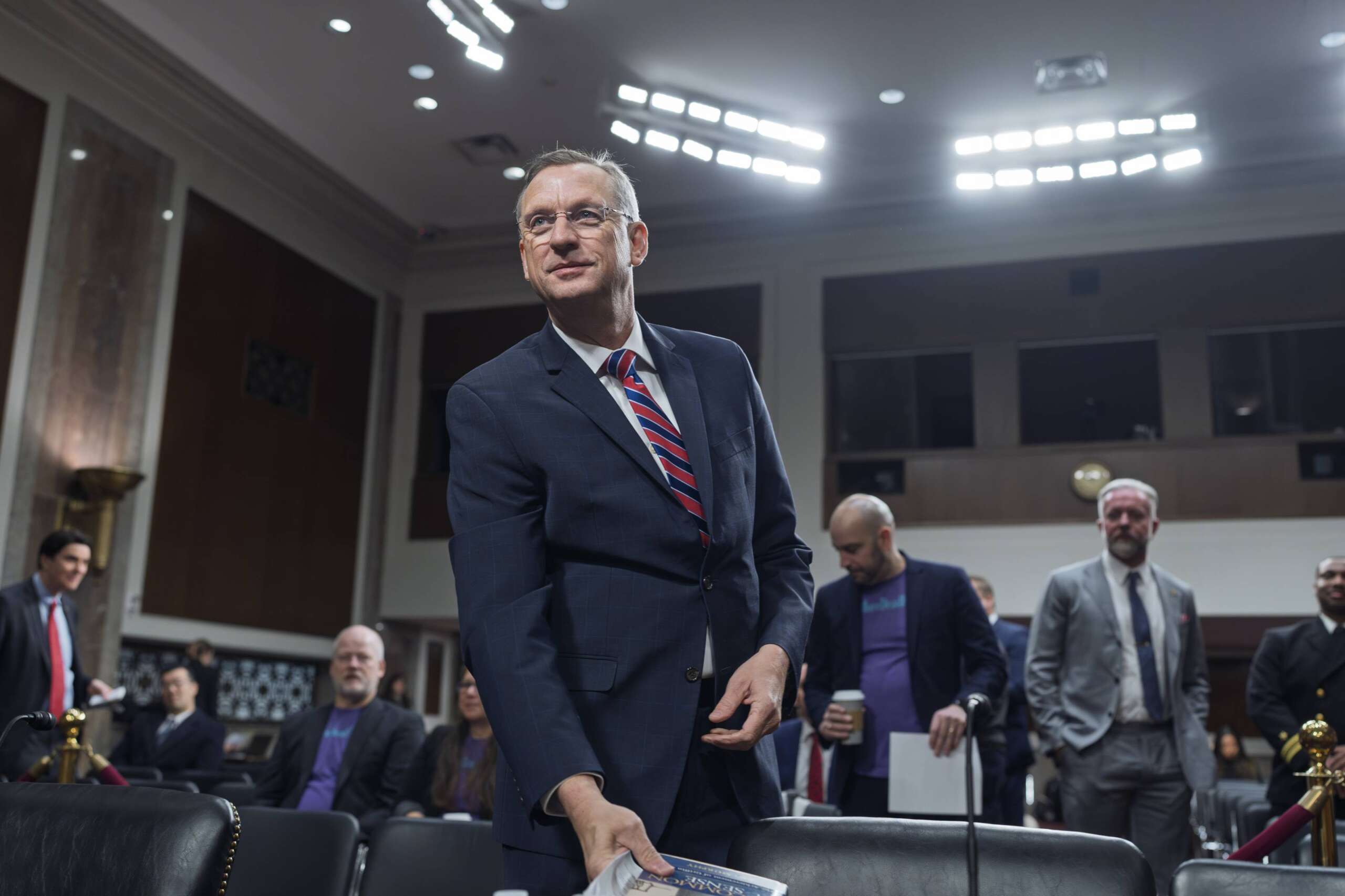
The Department of Veterans Affairs is preparing for significant cuts to its workforce, after hiring surged under the Biden administration.
VA Secretary Doug Collins defended the upcoming workforce cuts, saying increased staffing hasn’t always led to better service for veterans.
“The department’s history shows that adding more employees to the system doesn’t automatically equal better results,” Collins told the Senate VA Committee in a hearing Tuesday.
The VA ramped up hiring in recent years to handle record numbers of veterans seeking its health care and benefits. In fiscal 2023 alone, the Veterans Health Administration hired 61,000 employees — its highest rate of hiring in 15 years.
But Collins said increased staffing hasn’t always led to better service for veterans. Claims backlogs and appointment wait times, he told lawmakers, have gotten worse in recent years, “all while we were adding people and all while we were adding money.”
“We have doctors and nurses and other clinicians who are not actually being clinicians, and not reading charts or doing anything else. They’re actually formulating policy or doing administrative work. When I have this many folks that need to be more in the clinics, then we’re not helping the veteran,” he said.
An internal memo, first reported by Government Executive, showed the VA is planning to return to 2019 workforce levels. That plan would result in the department cutting about 83,000 positions.
Collins said the goal is to cut the VA’s workforce by about 15% — but said that figure is subject to change.
“It could be less, it could be more. It is a goal that you have to look at. You have to start somewhere,” he said.
Collins told lawmakers that leaks of recent memos, including one about upcoming workforce cuts, are “designed to make the VA look bad or make veterans scared.” He said the VA won’t share details of upcoming workforce cuts until a plan is finalized.
“It would not be right for us to do that in public. It would not be right for us to just come back and say, ‘Here’s everything that we’ve got,’ and then have everybody scared — because in the end, it may not be the final decision,” he said.
Collins said cutting nonessential VA employees will allow the department to spend more money on direct care to veterans, and that workforce cuts won’t impact health care or benefits for veterans.
“We’re going to maintain VA’s mission-essential jobs, like doctors, nurses, claims processors, while phasing out nonessential roles, like interior designers and other things — DEI,” Collins said. “This is savings we can achieve that will be redirected to veteran healthcare and benefits.”
There are bipartisan concerns about the VA’s upcoming workforce cuts. Committee Chairman Jerry Moran (R-Kan.) told Collins that bureaucracy at the VA “has hampered some of the department’s success.” But Moran said that cuts to VA’s workforce “ought not be a set number that you’re trying to reach.”
“As the VA undergoes restructuring, the department must be well-staffed by a quality, accountable workforce, and any efforts to right-size the workforce must be done carefully in a manner that treats men and women who entered public service to care for veterans with gratitude and respect,” Moran said.
Ranking Member Richard Blumenthal (D-Conn.) said the VA’s workforce expansion accounts the PACT Act, a 2022 law that expands eligibility for VA health care and benefits for veterans exposed to toxic substances during military service.
About two-thirds of the 83,000 VA employees hired since 2019 are health care employees.
“If you slash those health care workers, VA quality and access will diminish,” he said.
Collins has repeatedly said the VA hasn’t fired anybody who works directly with veterans. But Blumenthal said cutting support positions would also impact the level of care veterans receive.
“We know that support personnel are absolutely necessary answering the phones, clearing the surgical equipment, preparing the operating rooms, scheduling the appointments or fixing the IT systems,” Blumenthal said. “Those burdens will fall to others, or they will simply fall through the cracks, if you slash and trash the VA.”
Collins said the VA under his leadership is focused on ensuring veterans access the health care and benefits they have earned, while ensuring congressional spending “is not diverted to non-mission-critical or even wasteful programs.”
Lawmakers have passed or proposed legislation to reform the VA in recent years. But Collins said many of those plans have often been a “thinly veiled request for more employees,” adding that “money and people do not solve the problems” at VA.
Sen. Maggie Hassan (D-N.H.) told Collins it would be “impossible” to eliminate 83,000 positions without firing employees who provide health care to veterans.
About 370,000 VA employees work for the Veterans Health Administration, while the remaining 54,000 work in the Veterans Benefits Administration or other VA programs.
Collins pushed back on some questions about the impact of these workforce cuts, telling lawmakers that “the goal is not a fact.”
“Most people, when they state a goal, decide they’d like to reach it. If you don’t want to reach 80,000, revise your goal and tell us what you want to do,” Hassan said. “This witness and the VA cannot have it both ways. They cannot set out a goal and then get angry at us for asking what the impacts of that goal and those cuts would be,” Hassan said.
However, other members of the committee said they trust Collins to figure out the right-sized workforce for VA, and that Congress will have the final say on the department’s budget.
“I’m open to any suggestion that improves the condition for veterans, period. And I can’t say no to something because it makes me feel uncomfortable. I don’t know if it’s 83,000, 8,000 or 800 — but I have confidence in you to go through that process,” Sen. Thom Tillis (R-N.C.) told Collins.
Collins said some workforce reductions will be managed through “incentivized attrition.”
The VA, like many other agencies, has offered early retirement and incentive payments to convince some of its employees to leave their jobs. It also gave employees a second chance to sign up for “deferred resignation” and go on paid administrative leave through the end of the year.
The VA fired 2,400 probationary employees, but rehired about 1,4000 of them, as part of a federal judge’s order. Collins said the VA, to date, has only cut about 0.5% of its “non-mission-critical” employees.
“We want to work with Congress to fix the VA. But our shared goals need to be making things better for the veterans, not protecting a department’s broken bureaucracy. The Department of Veterans Affairs is not a federal jobs program. It is an organization whose sole purpose is to serve veterans, and we must never lose sight of that,” Collins said.
Collins is also focused on expanding veterans’ access to “community care” at non-VA medical facilities. The 2018 MISSION Act expanded veterans’ access to community care. But Collins said the VA in recent years has “stifled” that option for some veterans.
“Instead of sending people to community care, they were actually encouraged and fought to stay in the care inside the VA,” he said.
Republican lawmakers in both the House and Senate VA committees support expanding community care for veterans.
“It is so much more convenient for our veterans to get the health care that they have earned, and to get it in their communities when they want it, where they want it, at their convenience. I think that community care is something that should be moved on today,” Sen. Marsha Blackburn (R-Tenn.) said.
Collins said the VA will expand community care, while also ensuring VA care is available for veterans who prefer it. The VA is the largest integrated health care provider in the U.S., but Collins said it faces the same challenges as private health care providers when it comes to recruiting doctors, nurses and mental health professionals.
Collins said he’s calling on Congress to set higher pay caps for VA doctors. Former VA Secretary Denis McDonough also supported raising those pay caps, and lawmakers introduced bills in the last session of Congress that would have increased the maximum pay for some VA specialists.
“It’s very difficult to compete when you’re offering at some points, hundreds of thousands of dollars less to come work at the VA,” Collins said.
Copyright
© 2025 Federal News Network. All rights reserved. This website is not intended for users located within the European Economic Area.




